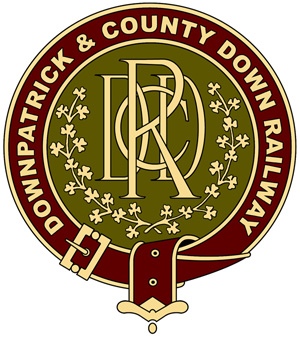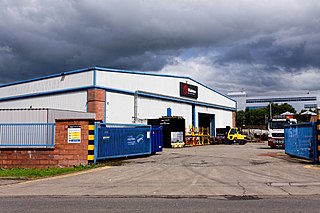
The Minnesota Transportation Museum is a transportation museum in Saint Paul, Minnesota, United States.

The West Clare Railway (WCR) originally operated in County Clare, Ireland, between 1887 and 1961. This 3 ft narrow-gauge railway ran from the county town of Ennis, via numerous stopping-points along the West Clare coast to two termini, at Kilrush and Kilkee, with the routes diverging at Moyasta Junction. The system was the last operating narrow gauge passenger system in Ireland and connected with the mainline rail system at Ennis, where a station still stands today for bus and train services to Limerick and Galway. Intermediate stops included Ennistymon, Lahinch and Milltown Malbay.

The Downpatrick and County Down Railway (DCDR) is a 5 foot, 3 inch gauge heritage railway in County Down, Northern Ireland. It is operated by volunteers and runs passenger trains using steam and diesel locomotives, diesel railcars, and vintage carriages. The railway has approximately three miles (4.8 km) of track in a triangular-shaped layout, which connects the town of Downpatrick with the historical sites of Inch Abbey to the north and King Magnus’ Grave to the south. It also houses a museum of railway artefacts and rolling stock originating from both Northern Ireland and the Republic of Ireland, dating from the 1860s to the 1980s.

The Mid-Norfolk Railway (MNR) is a 17+1⁄2 miles (28.2 km) preserved standard gauge heritage railway, one of the longest in Great Britain. Preservation efforts began in 1974, but the line re-opened to passengers only in the mid-1990s as part of the "new generation" of heritage railways. The MNR owns and operates most of the former Wymondham-Fakenham branch line of the Norfolk Railway. The branch opened in 1847, was closed to passengers in stages from 1964 to 1969 as part of the Beeching cuts, and was finally fully closed to goods traffic in 1989.

The East Anglian Railway Museum is located at Chappel and Wakes Colne railway station in Essex, England, which is situated on the former Great Eastern Railway branch line from Marks Tey to Sudbury. Services on the Sudbury Branch Line are operated by Abellio Greater Anglia.

The Cambrian Heritage Railways is a heritage railway company, trust and society based at both Llynclys and Oswestry in its newly restored Oswestry railway station, Shropshire, England.

The County Donegal Railways Joint Committee operated an extensive 3 ft narrow gauge railway system serving County Donegal, Ireland, from 1906 until 1960. The committee was incorporated by an Act of Parliament in 1906, which authorised the joint purchase of the then Donegal Railway Company by the Great Northern Railway of Ireland and the Midland Railway Northern Counties Committee.

Andrew Barclay Sons & Co., currently operating as Brodie Engineering, is a railway engineering company, specializing in the heavy maintenance, refurbishment and overhauls for both passenger and freight rolling stock. Based around its works at Kilmarnock, it is the only active rail engineering business in Scotland.

The Barry Tourist Railway is a railway developed to attract visitors to Barry in the Vale of Glamorgan, South Wales. It is a key element of the Barry Rail Centre which also includes engineering and training facilities.

The Scottish Industrial Railway Centre is an industrial heritage museum operated by the Ayrshire Railway Preservation Group. The centre owns a number of standard gauge steam locomotives and diesel locomotives as well as some narrow gauge items and an extensive collection of photographs.

The Pontypool and Blaenavon Railway is a 3.5-mile (5.6 km) volunteer-run heritage railway in South Wales, running trains between a halt platform opposite the Whistle Inn public house southwards to the town of Blaenavon via a two-platform station at the site of former colliery furnace of the Big Pit National Coal Museum.

Silver Stream Railway is a heritage railway at Silverstream in the Hutt Valley near Wellington, New Zealand. It regularly operates preserved New Zealand Railways Department locomotives along a restored section of the Hutt Valley Line before a deviation was built in 1954.

The Plains Vintage Railway & Historical Museum is a heritage railway and recreated historic village in the Tinwald Domain, Tinwald, New Zealand. The railway runs on approximately three kilometres of rural railway line that was once part of the Mount Somers Branch. The village and railway are open regularly to the public. The railway utilises preserved and restored locomotives and rolling stock once used on New Zealand's national railway network, while the village shows visitors how life was lived in New Zealand's pioneering past.
The South Gippsland Railway was a tourist railway located in South Gippsland, Victoria, Australia. It controlled a section of the former South Gippsland railway line between Nyora and Leongatha, and operated services from Leongatha to Nyora, via Korumburra, the journey taking about 65 minutes.

Steam Incorporated, often abbreviated to Steam Inc., is a railway heritage and preservation society based at the Paekākāriki railway station, Paekākāriki at the southern end of the Kāpiti Coast, approximately 50 minutes north of Wellington on the west coast of New Zealand's North Island. Unlike some societies who operate on preserved sections of closed branch lines, Steam Incorporated owns a depot beside one of the country's most important railway lines, the North Island Main Trunk railway, and restores heritage locomotives and rolling stock for use on excursions on the regular national rail network.

The Seymour Railway Heritage Centre (SRHC) is a railway preservation group based in Seymour, Victoria, Australia. The volunteer non-profit incorporated association was established in 1983 as the Seymour Loco Steam Preservation Group to restore and preserve locomotives and rolling stock as used on the railways of Victoria.

The Waitara Railway Preservation Society is a society established in 1999 to operate a heritage railway over the former Waitara Industrial Line railway that operated between Lepperton and Waitara in the New Plymouth District of New Zealand's North Island. The line had been closed that year after 124 years of operation, after the closure of the local AFFCO freezing works in the town.
The Great Central Railway (Nottingham) (formerly known as the Nottingham Heritage Railway) is a heritage railway located at the Nottingham Transport Heritage Centre (NTHC), on the south side of the village of Ruddington, in Nottinghamshire. The route consists of almost 10 miles (16 km) of the former Great Central Main Line from Loughborough South Junction (with the Midland Main Line) to Fifty Steps Bridge and the site of Ruddington's former GCR station, plus a branch line from Fifty Steps Bridge to Ruddington Fields station which is located on a former Ministry of Defence site next to Rushcliffe Country Park.

Fife Heritage Railway is a heritage railway run by The Kingdom of Fife Railway Preservation Society, formed in 1992, which aims to showcase the heritage of the railways of Fife and restore locomotives and rolling stock that once worked in Fife. They are based in Levenmouth, Scotland which has been their base since 2003.


















